Terrain to cry over
Showing that nothing exceeds like excess
This is an example of why wargamers with spare time on their hands should only be allowed to make gaming plans about a week in advance. As part of the “annual plan out the meetings in advance so we know what we are doing” idea, we decided to try out the 1914 rules by Great Escape Games ‘sometime in May’. This decision was made in about February. Having time on their hands and incipient insomnia, the terrain makers amongst us started work on some suitable terrain over which a decent ww1 battle could be fought.
All good, laudable and sensible so far. This record gives you an idea of the stages of making one of the terrain boards on which we fight our conflicts. It also shows that some of us have way too much time on our hands.
First, the starting point. The battle of the Geisterwald occurred on 5 October 1916 as part of a larger battle involving the Germans, Russians, Bulgarians, Romanians, and several other groups in the northern Balkans. Information gleaned from a variety of sources gave us a battle map that looked something like the following.
Looks fairly interesting and pretty straight forward to recreate for the table top.
We start with a basic piece of Masonite and sketch the basic details upon its pristine surface.
Some of the sifted saw dust flock ready for the ‘Mud and the Blood’ part.
All the hilly bits with a modicum of cover.
Now the next lot of coloured flock for the basic fields and open spaces.
Some more sections filled in. The first lots of muddy bits go in. Saw dust, paint and PVC. Then the truncated village buildings get plonked on their places.
A closer view of one of the hilly bits.
All done for the basic covering.
The stage is now set for fiddling and finessing.
Starting to add texture to some of the sections.
More definition on the roads and texture to the main hilly bit.
A bit like this.
Dummy place markers for the bridges.
Haystacks etc for that rural feeling. Plus the start of the hedging along the roads and detail around the village.
Water effects in full flight. Plus more detail of terrain variations.
With way too much time on our hands the start of putting stuff in the plantation areas and some wheat fields.
About as agricultural as you can hope for...
You can see the affect that excessive overnight heat can have ; a sort of milky white. It’s not a problem but it was a bit annoying.
The final product ready for battling over.
There is still serious discussion about picking out the watery bits and pouring the mixture again.
Hopefully this gives you some idea of just how dedicated we are.
Or just how stupid we are
Either way, the board cost about $20 to make. Most of that cost was the glue and fixative. The sawdust was free, the tissue paper cost about 5 cents, the paint about $2 and the rest was made up from various bits lying around the shed. For those concerned about such things this was completed in about a week working a couple of hours a night.
Not bad for talentless buggers.



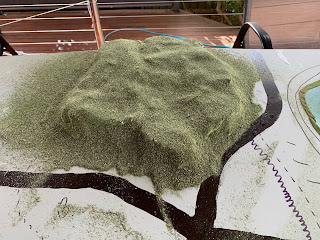








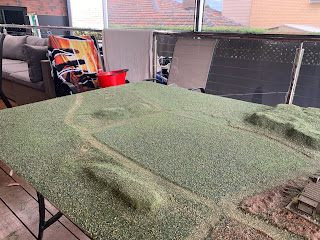

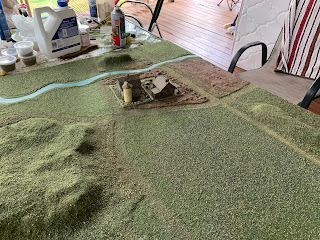


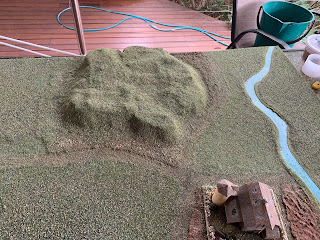

















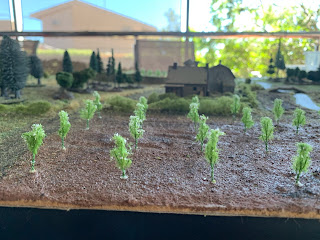




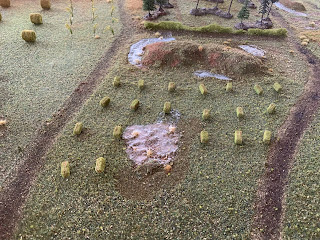

Great stuff, with only one tiny kvetch. Round Hay bales/rolls like that are entirely modern, being created by machinery, and out of place in an pre 1980 setting. Up till then they would be piled hay. Even hay bales are modern, being produced by a mechanical baler. Terrific looking setup.
ReplyDeleteExcellent table and looks like it cost a lot more than $20 to make!
ReplyDeleteVery impressive!